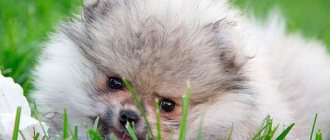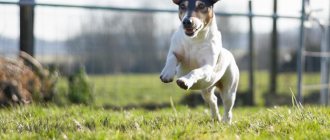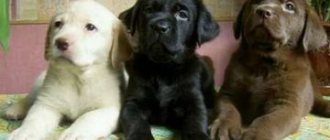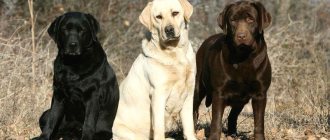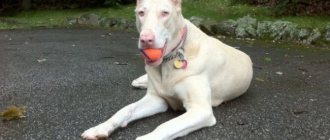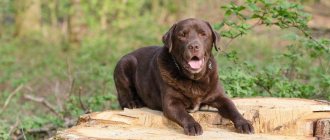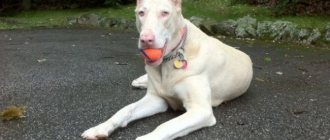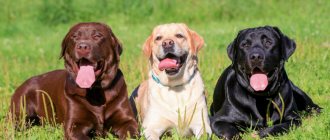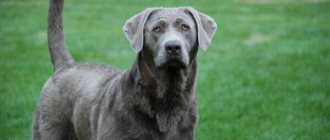The color fawn is mysterious and very interesting. It evokes different associations in different people: some imagine it pale and “burnt out”, others see it as bright and expressive. Well, let’s dispel all the myths and tell you what the fawn color really looks like (the photos presented in the article will help with this), where it is found and what shade varieties it has.
Peculiarities
Adult representatives of the Labrador breed are large and muscular dogs.
They have a rather dense and strong build, a wide head, a strong neck and pronounced drooping ears. Labradors are distinguished by a wide chest, a strong and fairly short lumbar region. The paws are powerful, but at the same time compact. The tips of the paws are rounded. Between the toes of the animal there are leathery membranes reminiscent of duck limbs. Thanks to this feature, Labradors are excellent swimmers.
A distinctive feature of the Labrador's exterior is its tail. At the base there is a noticeable thickening, gradually moving to a narrowed tip. Its surface is completely covered with hair. In appearance, the Labrador's tail is somewhat similar to the tail of an otter.
The coat of these noble dogs is straight, short and hard to the touch.
Its important feature is water resistance. After bathing, a Labrador only needs to spend five minutes in the air and its coat will be dry again
Inside the “cloak” there is a developed undercoat that protects the animal from the cold.
For this reason, even Labrador puppies can spend more than half an hour in cold water.
Inside the “cloak” there is a developed undercoat that protects the animal from the cold. For this reason, even Labrador puppies can spend more than half an hour in cold water.
According to exterior standards, golden, black and chocolate coat colors are allowed. Although the most common and often seen on the street are the golden and black representatives of the breed. Dogs with dark chocolate colors are a little less common, but each brown individual attracts the admiring glances of others.
According to the standard, the height of adult males at the withers is 57 cm, females are slightly smaller - 54 cm. The same applies to the weight of animals. The weight of males should not exceed 40 kg, and females - no more than 35 kg.
Quite often, inexperienced breeders believe that a Labrador and a retriever are the same dogs, but in fact this is not the case. Among retrievers, the most popular are goldens - owners of long and soft hair. Perhaps this is the main difference between the presented breeds.
As for chocolate Labradors, in addition to the unusual coat color, these dogs are distinguished by the special color of their ear lobes, nose and eyes. Sometimes they can be pink, but this fact does not in any way affect the beauty of the animal.
Chocolate-colored puppies with a pronounced blue eye shade look very elegant. Of course, in most cases, as the animal grows older, the eye color changes. Although there have been cases when the pigmentation remained blue until the death of the animal.
Relatively recently, chocolate Labradors were recognized as a separate breed of animals. Today they have an assessment identical to the golden and black representatives of the breed.
How do you get the desired color when crossing?
First of all, you need to thoroughly study the pedigree of both partners in order to understand which pigment is dominant in the dog’s ancestors. To correctly predict the color of the future offspring, you need to take into account the color of the parents’ fur coat:
- For example, if mom and dad are chocolate, then the puppies are likely to be red or black. But not gray.
- And if future parents have sable or cream fur, then they almost always give birth to sable or cream puppies, respectively.
- Brown pets give birth to brown babies. You won't be able to get any coals. The same applies to red representatives of the breed.
- Gray or purple Chihuahuas give birth to yellow or sandy puppies.
- And red-haired pets always give birth to red-haired babies, because the “redness” gene is dominant.
There is another type of Chihuahua color called “merle,” or otherwise marbled. Marbled sneezes are native to America. Despite the unusual spotted appearance, "merle" is not recognized by the RKF (only in the case of Chihuahuas). And this is due to frequent health problems in such pets. For example, marbled sneezes often have problems with their eyes and hearing. And sometimes it even happened that marbled chihuahuas had no eyes or ears.
Which color do you prefer?
Reviews from Labrador owners indicate that light-colored dogs evoke more positive emotions; they look more friendly and cheerful. However, they get dirty much faster.
Chocolate labrador puppy.
Chocolate Labradors lose the intensity of their color in the summer, their coat fades and can take on a rather unpresentable appearance by autumn. You can try to keep your chocolate Labrador in the shade, but these dogs are very active, and it is not always possible to protect him from the sun's rays. The color will return with the onset of cold weather, especially if you give the dog special vitamins to enhance pigmentation.
Brown fur makes it less obvious when a dog is dirty. This point deserves attention, since all Labradors, without exception, love to wallow in the mud. Not a single puddle or ditch will escape their attention. After such a mud bath, it is impossible to look at a light Labrador without laughter and tears. It’s funny to see the expression of incredible happiness on his smeared face, and tears come from the thought of how he now has to clean up this hooligan.
Black Labrador.
Black dogs look the most solid and impressive, especially considering the size and weight of the Labrador. Labradors are very protective dogs, but a large black dog walking next to you may well scare away hooligans ignorant of dog breeding with its very appearance. Especially if you train your pet to wear a collar and muzzle. People have certain stereotypes, and one of them says: a large black dog in a muzzle is most likely dangerous and aggressive, it is better to be careful.
In fact, black dogs have only one drawback, judging by the reviews: a black Labrador is very difficult to photograph beautifully. Lighter dogs are more photogenic, but black beauties are absolutely irresistible in real life.
Labrador Dudley.
There is another type of color that is considered unacceptable according to the standard. It is called Dudley and is characterized by a lack of pigment. Dudley dogs have light eyes that can be bright green or light yellow. The eyelids, lips and gums are pink, completely devoid of pigmentation, and the nose is pink. If you don’t have to take part in dog shows with your dog, then you can take such a puppy if your heart is drawn to it.
When reaching adulthood, non-standard dogs are usually sterilized to avoid accidental matings. There have also been cases of births of silver Labradors. These dogs are extremely rare, very beautiful and very expensive, despite the non-standard color and the impossibility of an exhibition career.
Variety of shades
Very often the color fawn is found in painting, but many, not knowing it, ignore it, calling it pastel, beige, yellow, and so on. The fact is that this tone has many shades, among which are ordinary light yellow, pale yellow (mixed with white), pale orange, ocher, sand, dark yellow, and in some cases even sable (like coat of this animal). Based on such data, we can assume that the fawn color is most likely present in summer landscapes where the sea is depicted, creating an atmosphere of warmth and comfort. It also takes pride of place in autumn still lifes, but plays a secondary role there. Often, with the help of this tone, objects on canvas are made more voluminous, lively, and multifaceted.
Kelpie
The species, bred in Australia, has a muscular body with flexible limbs. The height of adult individuals can reach 51 cm at the withers. The general appearance of this herding dog resembles that of a fox. The wide chest, short and compact legs make the breed incredibly tireless.
The individual has a double coat of medium length with a thick undercoat. It is longer under the body and on the back of the thighs than on the rest of the body. Just like many animals of Australian origin, the kelpie has a visual collar formed by longer fur.
The most common dogs are chestnut, yellow-brown and red-brown in color. Kelpies are slightly susceptible to shedding, but to maintain a shiny coat, they should be brushed every other day.
How do puppies change as they age?
At 1 month, puppies rapidly gain body weight and have a large appetite. After the eyes open, you should make sure that their irises are the same color.
Puppies are agile and slightly clumsy; by the end of the first month of life they reach a weight of 1-1.5 kg.
At 2 months, puppies learn to stand on their hind legs with emphasis on a hard surface, playful and funny. During this period, their ears become fully erect, the spots on their body become more distinct, their weight reaches 2.5 kg, and the puppies begin to remember their name.
At 3 months, the replacement of baby teeth (incisors) begins, skin folds become more noticeable, and weight reaches 3-5 kg.
From 4 months, fangs are replaced, and increased growth of tubular (long) bones begins. From this month, puppies begin to toilet train or ask to go for a walk , weight ranges from 4 to 6 kg (girls are usually smaller than boys).
At 5 months, the puppy’s small molars are replaced, muscle mass is gained, and the weight reaches 7-8 kg.
At 6 months, males weigh up to 10 kg, females - up to 8-9 kg, the rate of weight gain increases by 2.5-3 times , the height at the withers reaches 35-37 cm.
At 7-8 months, the change of teeth is completed, the growth of tubular bones slows down, the muscle relief is clearly visible, the mask on the muzzle is clearly visible, and the weight reaches 12 kg.
At 9 months, puppies are actively exploring the world around them, are able to remember and follow commands, are trainable, and weigh up to 13 kg.
From the 10th month, the jaw is maximally developed, the bite is fully formed, and the weight is 14-16 kg.
At 11-12 months, puppies gradually approach the appearance of an adult dog:
- folds and color are well defined;
- all muscles are developed;
- the back is strong;
- cylindrical chest;
- The dog is active and physically strong.
The weight of a puppy of eleven to twelve months reaches 15 kg.
Read more information about the weight of French bulldogs here.
Brown Labradors - what they look like
Initially, experts recognized only black-colored individuals as purebred. The first dogs imported from Great Britain had this shade, which was the reason for the long rejection of other colors. Over time, the fawn Labrador was recognized, but the situation with chocolate remained unchanged for another 100 years.
Later, the chocolate-colored Labrador was included in the list of purebred animals. It is known for its attachment to its owners; with a lack of attention or a long absence, the pet is capable of upending the entire house or howling loudly and mournfully.
The list of positive qualities of representatives of the breed includes:
- innate hunting instincts - the animal’s excellent sense of smell allows them to easily navigate the forest or swamps, search for game and birds;
- high intelligence - diligence and intelligence allow them to work as a bloodhound or a guide;
- Easy to care for - thick and short hair does not cause problems; regular brushing every week is enough.
Short-haired pets do not suffer from lack of appetite and are absolutely not picky about food. The disadvantages of pets include:
- hereditary predisposition to a number of diseases;
- high feed consumption - up to 500 g daily;
- lack of innate malice - they are not suitable for the role of guards;
- damage to things - animals love to chew on all available objects.
Inexperienced beginners often confuse the representatives of the group and call the Golden Retriever a long-haired Labrador. The main difference is the long wavy and silky coat.
Important! Dog experts do not recommend keeping a brown retriever or a cream Labrador in a small apartment; he needs more space and frequent walks. Variety of colors
History of origin, characteristics and character traits
Labrador chocolate appeared during the same period as its fawn and black counterparts. Brownish shades are not passed on from older to younger generations, so breeders have done a tremendous amount of work to obtain the desired color.
Canine associations recognized it as a separate branch only towards the end of the 20th century. Until this time, he could not take part in exhibition events. Initially, “rejected” individuals did not have the right to participate in breeding; they were sent to farms.
There is no identical coat tone for all chocolate Labradors.
Experts note that regulation of color intensity depends on a set of dominant and recessive genes. The following shades of wool are distinguished:
- hepatic;
- light brown;
- chocolate;
- dark chocolate.
The brightness of the tone depends on the sufficient supply of vitamins and minerals to the pet’s body.
Among ordinary people there is a mistaken impression that the color scheme affects the character of the animal. In fact, a dark brown Labrador is no different in this regard from a light one. All variations of shades do not prevent dogs from being kind, playful and sociable. Dogs are suitable for the role of companions, they will not interfere in a family with small children, but they are not able to reliably protect household property.
Their good disposition helps them easily get along with other pets, classifying cats and brothers as friends. Birds, rodents and other inhabitants are not perceived by chocolate-colored dogs as objects of hunting
Distinctive character traits of a pet include love and increased attention to the whole family, regardless of age. He will become a nanny for kids, and a good companion for adults.
Important! Animals' keen sense of smell allows them to sense 25% more than their fellow creatures. Labradors can be used as guide dogs, police dogs, and state border guards.
They are often involved in rescue operations and searches for prohibited substances. Cream Labrador puppy
Stylish looks with fawn color
With the help of soft, gentle and romantic fawn it is easy to create a lot of bright and seductive images. The muted sunny color looks chic in any situation. It is often chosen by Hollywood stars to walk the red carpet.
A total look in pale yellow is an always up-to-date solution that will make you stand out from the crowd. You can use one shade or play with tones that are slightly different from each other. Also, to create stylish outfits, you can take one wardrobe item or accessory in this color. You will see how your appearance will be transformed for the better with a light yellow skirt, trousers, coat or jacket.
Things of a muted yellow color look very interesting in combination with clothes that have various prints. Try combinations with stripes, checks, fancy patterns or a clear geometric pattern, and you will see how your look will sparkle in a new way.
The beautiful and functional shade that we looked at in this article makes the fair sex fall in love with it at first sight. And this is not surprising, because it suits everyone. Whatever fawn look you choose, you will always look stylish and impressive.
Standard in breed color
The Labrador Retriever is something of a mystery breed. When you get a pet, you don’t know what color offspring you will get. The color of a Labrador is based on genetics and pedigree.
Genetics
Therefore, experienced breeders take care of the purity of the breed and keep track of the colors of the puppies’ parents and grandparents. This information is provided to the future owners of the retriever if they adopt the dog.
Let's consider the genetic basis of the influence on color. In accordance with the formulas, B and E are black coat color, b is the gene responsible for chocolate color (recessive), e is fawn color (also recessive). A total of nine combinations are possible. Each parent passes two genes to the baby. If a puppy is born from black parents, then it has the following possible combinations of genes - EEBB, EEBB, EEBb, EEBb.
Moreover, if one of these combinations continues the race with a cream-colored retriever (gene combinations - eeBB, eeBb, eebb) or with a dog whose coat is the color of chocolate (gene combinations - EEbb and Eebb), then the puppies will have a black, fawn or brown color , depending on the combination.
It is important to remember that a dominant trait will appear in any case. Therefore, when mixing two cream retrievers, it is easy to get a tar-colored puppy, without knowing who his ancestors were based on the combination of genes.
When getting a dog of one color or another, people are guided by sympathy or fashion
Light, white Labrador looks friendlier than chocolate, which is less common, which increases their cost, and black ones are strict and massive
When getting a dog of one color or another, people are guided by liking or fashion. Light, white Labrador looks friendlier than chocolate, which is less common, which increases their cost, and black ones are strict and massive.
Important! The standard always provides for one shade of fur out of three - the dog should not have spots. The color of the eyes, nose, eyelids and lips should be as dark as possible
Black Labrador
The standard for a Labrador with black coat is only tar color, no spots and no light hairs.
One white spot can only be on the chest. The nose should be black, the eyes should be hazel or brown (ideally the color of dark chocolate).
Chocolate Labrador
The rarest combination of genes, which increases the cost of purebred puppies. There are several shades of this coat color: light chocolate, liver, black (bitter) chocolate. Labrador must be one color.
When choosing a dog of brown shades that you plan to raise for participation in exhibitions, look at the uniformity of coloring - there should be no transitions of colors, spots or stripes. In puppies of this color, the eye color is often brown, turning to yellow, but the best is a dark shade of the nose and eyes. The color of the pupils can change, but the final color is formed by two years.
Important! The coat of retrievers of this tone fades in the sun. You need to know this when making a friend of this color
Keeping your dog in the shade will not work due to their activity.
But by winter they darken, which does not affect the quality of the wool. Spots are also disqualifying signs of color
Keeping your dog in the shade will not work due to their activity. But by winter they darken, which does not affect the quality of the wool. Spots are also disqualifying signs of color.
Fawn Labrador
A shade that has become very popular and was not initially considered a standard. Until 1924, all cream dogs were considered a waste, only black Labradors were an acceptable option. Now there are farms that specifically breed retrievers of only cream shades.
Breeders breed dogs in which recessive traits predominate in the first generation. This coat color indicates the presence of three color genes, which, with different combinations, will produce babies of all three primary colors of this breed.
There are several colors for light wool: golden (Labrador Golden), light cream (beige) and almost red (fox), light liver, gray. The eyelids, eyes, and lips of a golden Labrador should be dark or black. The animal’s face should not have a pronounced “mask” of a dark brown hue, which is a disqualifying defect, as are spots.
Important! The standard color for a Labrador excludes the presence of spots of a different shade of fur in addition to the main one. There may be only one small white spot on the chest
Proper care
There are no problems with keeping a dog. It is compact and requires a small, specially designated corner in which a rug or a special bed rests. The bulldog's coat is short, does not emit a characteristic dog odor and does not cause problems when shedding. The only thing that is required of you is to comply with a number of hygiene procedures:
- brushing your pet once a week with a soft brush;
- washing – once every 2 months (more often if necessary);
- wiping the ears once a week;
- wiping the folds on the muzzle and the area under the tail. If this requirement is not met, your pet may develop fungus in the folds of the skin or experience irritation;
- Brush your teeth once a week with a special brush, monitor their condition (do not give bones in large quantities).
Attention!
The coat of a French Bulldog is an indicator of the dog's health. If it becomes dull, it is advisable to contact your veterinarian.
Nutrition
The basis of the dog's diet should be meat (70% of the daily diet). It forms the natural microflora of the digestive organs and protects the dog from infections through the gastrointestinal tract. Fits:
It is possible to use liver, kidneys, heart, but in boiled form. The rest of the diet consists of cereals, vegetables and fermented milk products. The dog has weak digestion, it is advisable to avoid foods that cause flatulence and whole milk. It causes bloating and stool problems in the animal. It is advisable to feed twice a day: morning and evening. Give liquid 30-40 minutes after eating.
Attention!
Twice a year, include a course of multivitamins and microelements in your dog’s diet. It is advisable to do this in autumn and spring.
Nutritional Features of the French Bulldog
Physical activity and walking
The Bulldog is active, but does not have the endurance to walk long distances - it quickly runs out of steam. This is due to the anatomy of the breed. It is advisable to choose a limited space for walking in which the dog can chase a stick and run freely.
Outdoor group games
A characteristic feature of the “Frenchie” is bulging eyes; during active games, injuries often occur. Make sure that the bulldog does not bump into branches or twigs.
The spine of this breed also has its own distinctive features - an additional 1-3 vertebrae are built into the spinal column. Protect your dog from jumping. Their consequences can be injuries and dislocations, the formation of a vertebral hernia, which is difficult to treat.
Short, thin fur does not protect the dog from temperature changes. When the sun is hot, the animal can get sunstroke, and in cold weather it can become hypothermic and get sick. In summer, try to go for a walk early in the morning and late in the evening, when the heat subsides. And in cold seasons, dress your bulldog in warm overalls that protect from frost and wind.
Important!
It is advisable to take walks twice a day for up to 1 hour.
French bulldog on a winter walk
In the next article we will talk about the sores of Frenchies...
Labrador is a classic. In cinema, literature, and painting, these dogs are found quite often, and therefore are very recognizable and discussed. Thus, there is a misconception that the color of a Labrador is related to its character: white dogs are lazy, black dogs are energetic hunters, and a brown puppy will grow up stubborn and cunning. But any breeder will easily refute this. But no one will deny that in this breed the color of the coat never matches the undercoat.
Three colors of Labrador
According to the standard, Labradors come in three colors:
- Black;
- Chocolate;
- Fawn.
Black coloring is considered traditional and is complemented by brown or hazel eyes and dark earlobes. A dog with such fur shines and shimmers in the sun. The blackness can be diluted with a white spot on the chest or tan marks.
The “boom” of dogs with brown fur has not yet passed, and more and more people want to have such a spectacular pet.
The combination of chocolate color with hazel or yellow eyes is also interesting. However, “rich” chocolate must be properly cared for: do not keep dogs in the sun for long and feed it with special vitamins.
Labradors with fawn coats come with golden, light cream, red tint or brown pigmentation.
Who suits fawn color
The nobility of fawn, its mutedness and tenderness help it fit harmoniously into the spring, autumn and summer wardrobe. It looks appropriate in both cloudy and sunny weather; it is a universal color that fits perfectly with the appearance of any color type, perfect for both brunettes and blondes.
This calm color looks amazing in many styles, such as casual, urban, rustic, shabby chic, etc. It looks best in solid-colored clothing for creating everyday looks. It is also possible to use it in accessories: a light yellow handbag or belt refreshes and adds elegance to the appearance.
Fawn-colored items look perfect on girls of the summer color type. Fair-skinned brunettes with winter appearance are recommended to choose a bright straw color for themselves. If you are a spring color type, pay attention to clothes in light colors. And for autumn ladies, a variety of straw shades are perfect.
If you want to look stylish and impressive on vacation, choose a monochromatic beach look in fawn color. In other cases, when creating a look, you can stop at only one item of clothing of a given shade. For example, a fawn coat or fur coat looks very beautiful and extraordinary.
List of nicknames
When a new family member arrives home, the first thing new owners do is choose a suitable name for the animal. You always want to choose the most unusual name for your pet, so that it reflects the character of the dog, emphasizes its appearance, advantages, and most importantly, is heard by the dog itself.
Scientists say that dog names should be easy to pronounce. It is desirable that they consist of one, maximum two syllables. For better perception by the dog, the letters “P” and “L” should be present at the base of the name.
Quite often, names in the English style are chosen for chocolate Labrador boys. For example, Chester, Harry or Harley. Some owners name their dogs according to their size. For example, for males the ideal nicknames would be Goliath or Maximus. For a fragile baby, the name Weenie will do. Males who reveal their friendly character to the maximum are awarded such nicknames as Smile or Joy.
When choosing a female nickname, you must be guided by similar rules with the only exception - the female’s name should sound softer and more feminine. Quite often, when choosing a nickname for a chocolate girl, human names are used that are very popular in England, for example, Gina, Wanda or Hannah.
When choosing a female nickname, some owners rely on information from the exterior standard. Thus, the chocolate baby may turn out to be Gracie or Vivienne. Breeders who believe in the mystery of numbers call their pets by names related to the time of year or the month the dog was born, for example, Winter or Martha.
Often, owners of chocolate Labradors try to name their pets with names that speak about the beauty of the animal’s coat color. For example, brown babies may be nicknamed Brownie, Bruno, Latte, Chestnut or Iris. Other dog lovers choose the names of famous actors, composers or scientists for their animal. In the park you can meet a chocolate Labrador named Tyson, Perron, Mozart, Russo or Elvis. Connoisseurs of geographical sciences reward their pets with nicknames consonant with the names of rivers, cities or countries, namely Dakota, Verona, Marseille.
If children who love fairy tales, legends and myths choose a nickname for a small chocolate-colored puppy, they will most likely offer options such as Zeus, Hercules or Odin. Very young children will want to name their pet nicknames similar to the names of cartoon characters, for example, Casper, Goofy or Simba.
If the family has a sense of humor, the animal's nickname will also have an original and funny meaning.
Truffle. In this case, we are not talking about mushrooms, but cakes. They are the same chocolate color as a puppy's fur.
Buckwheat. Similar to the first proposed option, the characteristics of hair color are emphasized.
Bullet. This nickname characterizes the dog's manner of movement.
Artist
This name is given to dogs that love the attention of the public and are ready to show their talents and qualities in order to receive the praise and approval of others.
Mamai. Labrador puppies may not necessarily become neat creatures in the future.
They will completely accidentally be able to demolish many objects on their way.
Color groups
Experts divided all the variety of colors into several main groups. They include both single-color and multi-color variations of shades and patterns.
Solid
The solid color of tetrapods is distinguished by the presence of only one shade on their body. On the other hand, it may be its complete absence. The substance eumelanin forms black or chocolate pigmentation with varying degrees of saturation. The lightened form of this type is called blue or beige.
The substance pheomelanin is responsible for the red or deer variant. And the lightened form of the pigment gives a sandy background with variations from white to light cream.
Mixed
A mixed group appears by combining a pair of shades. Moreover, the white tone should not participate in the mixing. The variation in the colors of the dog is influenced by the presence of the substance eumelanin or pheomelanin. As a result of the manifestation of these two pigments, 5 types of mixed tones are distinguished:
red with a black mask on the face;
red with some darkening;
black with reddish tan;
red with black undertones.
All types of these variations are characterized by some lightening and a special placement of pigmented fur on the body of the four-legged friend. The mask, in turn, is combined with each of the four tones.
Modified
The mentioned groups may change with age. So, spots, bleached or piebald areas appear on the fur. However, lightened dog coat color is common in many breeds, and this is in no way due to age-related changes. It’s just that a pet is born with pigment, but over time it loses it.
This modification can be observed in combination with any base tone. For example, dark spots or variegated shades are clearly visible against gray and lightened backgrounds. This is the so-called marble tone.
White spots are formed due to a complete lack of pigmentation on certain parts of the pet’s body. There are pets that have white spots located almost all over their body, and only their ears are colored.
Character of Labradors
The Labrador Retriever has a balanced sanguine temperament. He is agile, as they say, easy to climb, but at the same time he calms down without any problems
Another important advantage is a good ability to adapt to any situation.
Dogs of this breed are distinguished by developed intelligence, they are insightful, obedient and responsive. The Labrador cannot be called stubborn, like the Japanese Akita or Shiba Inu; he is not long-thinking, like the “Caucasian” or “Central Asian”. But he is not such a servant as a German shepherd.
The Labrador Retriever is a very good-natured and friendly dog. He is affectionate and friendly, not only with members of his household, but with everyone. There is absolutely no aggression in the character of this dog; the role of a guard is categorically not typical for it. Although a labric would be quite suitable for a defender. Thanks to his impressive appearance, he scares away unpleasant individuals from a distance. After all, not everyone knows that this big guy is incredibly kind
In addition, if a conflict arises, the Labrador will not be afraid and will bravely defend its pack
This dog is an ideal pet for a family with children; he will carefully look after and entertain everyone. But the child must be able to handle animals. And parents need to make sure that during stormy games the dog does not accidentally drop the baby. Labrador gets along well with other pets, although it is better to accustom him to rodents and birds from childhood.
Labrador Retrievers are people-oriented, so they want to socialize a lot and be helpful. Thanks to this, they become guides for people with low vision, assistants in hospitals and institutions for people with disabilities. Dogs are especially good at establishing contact with children and adults who have mental problems. They have a positive influence on their comrades, calm them down, and relieve stress.
As a rule, Labradors adore their owners and try to accompany them everywhere. And loneliness depresses them, they get bored. These dogs are not suitable for someone who is away from home all day.
Dog colors: description, variations, rare species
When choosing a pet, the future owner gives preference not only to a specific breed. Often people pay attention to the color of the dog. After all, animal fur contains a wide palette of colors and shades that can amaze with their combinations and patterns. The appearance of the dog depends not only on the breed, but also on genetic conditioning.
Standard in breed color
The Labrador Retriever is something of a mystery breed. When you get a pet, you don’t know what color offspring you will get. The color of a Labrador is based on genetics and pedigree.
Genetics
Therefore, experienced breeders take care of the purity of the breed and keep track of the colors of the puppies’ parents and grandparents. This information is provided to the future owners of the retriever if they adopt the dog.
Let's consider the genetic basis of the influence on color. In accordance with the formulas, B and E are black coat color, b is the gene responsible for chocolate color (recessive), e is fawn color (also recessive). A total of nine combinations are possible. Each parent passes two genes to the baby. If a puppy is born from black parents, then it has the following possible combinations of genes - EEBB, EEBB, EEBb, EEBb.
Moreover, if one of these combinations continues the race with a cream-colored retriever (gene combinations - eeBB, eeBb, eebb) or with a dog whose coat is the color of chocolate (gene combinations - EEbb and Eebb), then the puppies will have a black, fawn or brown color , depending on the combination.
It is important to remember that a dominant trait will appear in any case. Therefore, when mixing two cream retrievers, it is easy to get a tar-colored puppy, without knowing who his ancestors were based on the combination of genes.
When getting a dog of one color or another, people are guided by liking or fashion. Light, white Labrador looks friendlier than chocolate, which is less common, which increases their cost, and black ones are strict and massive.
Important! The standard always provides for one shade of fur out of three - the dog should not have spots. The color of the eyes, nose, eyelids and lips should be as dark as possible.
Black Labrador
The standard for a Labrador with black coat is only tar color, no spots and no light hairs.
One white spot can only be on the chest. The nose should be black, the eyes should be hazel or brown (ideally the color of dark chocolate).
Chocolate Labrador
The rarest combination of genes, which increases the cost of purebred puppies. There are several shades of this coat color: light chocolate, liver, black (bitter) chocolate. Labrador must be one color.
When choosing a dog of brown shades that you plan to raise for participation in exhibitions, look at the uniformity of coloring - there should be no transitions of colors, spots or stripes. In puppies of this color, the eye color is often brown, turning to yellow, but the best is a dark shade of the nose and eyes. The color of the pupils can change, but the final color is formed by two years.
Important! The coat of retrievers of this tone fades in the sun. You need to know this when making a friend of this color
Keeping your dog in the shade will not work due to their activity. But by winter they darken, which does not affect the quality of the wool. Spots are also disqualifying signs of color.
Fawn Labrador
A shade that has become very popular and was not initially considered a standard. Until 1924, all cream dogs were considered a waste, only black Labradors were an acceptable option. Now there are farms that specifically breed retrievers of only cream shades.
Breeders breed dogs in which recessive traits predominate in the first generation. This coat color indicates the presence of three color genes, which, with different combinations, will produce babies of all three primary colors of this breed.
There are several colors for light wool: golden (Labrador Golden), light cream (beige) and almost red (fox), light liver, gray. The eyelids, eyes, and lips of a golden Labrador should be dark or black. The animal’s face should not have a pronounced “mask” of a dark brown hue, which is a disqualifying defect, as are spots.
Important! The standard color for a Labrador excludes the presence of spots of a different shade of fur in addition to the main one. There may be only one small white spot on the chest.
History of the breed
This dog breed owes its origin to English and Spanish bulldogs (Alans) and was bred in the mid-18th century in England.
The appearance of the breed is associated with the widespread dog fighting of that period and the need to breed a small fighting dog. However, French bulldogs quickly emerged from the ranks of similar breeds and became popular among English society as pets, rat-catchers and companions.
The dogs easily endured transportation by hand, which led to their migration from England to France, where bulldogs could only be purchased by members of the French elite. The breed was registered in France, and the first presentation of dogs at an exhibition dates back to 1896.
NOTE!
After recognition by the European Canine Federation, French bulldogs began to appear in America as one of the most expensive breeds (the price per puppy ranged from 550 to 5000 dollars).
In the 20th century, dogs spread into elite circles in Russia, gaining the status of prestigious and fashionable pets.
During the Great Patriotic War, the breed almost disappeared from the country, spreading again after 1950 as an ornamental breed, ceasing to be considered a hunting type dog.
Does coat color change over time?
You can understand in advance whether the dog will change its color. Breeders use special methods to determine possible recoloring. If a puppy is born brown, its coloring may become darker over time. This fact can be determined using the color of the nose: if the nose of a light brown individual is dark, the coat will also become darker as it grows older.
Black dogs can acquire golden pigment. The tone of the undercoat can help predict this event.
Most often you can encounter overcoloring of the following dog breeds.
- Spitz. Overcoloring is characteristic of individuals whose ancestors were carriers of non-standard colors.
- Yorkshire Terrier. These animals will change their color for up to 12 months. This characteristic is specified in the breed standard.
- Rottweiler. In these individuals, the tan may become brighter, and there are also cases of black spots appearing.
- German Shepherd. You can often encounter a situation where three-month-old babies born tan became black-haired.
- Kerry Blue Terrier. Representatives of this breed are black in color at birth. After some time, the fur acquires a silvery pigment.
- Dalmatian. Most puppies are born with white fur. On the 14th day of their life, spots appear. The process of developing black spots lasts up to two months.
- Bobtail. Juveniles often have a monochrome coloration. After some time, the black marks turn blue.
In the next video you will find an interesting lecture on the genetics of dog color from Pedigree.
Characteristics and description of the breed
The homeland of small bulldogs is the English city of Nottingham, where they were bred and lived until the 19th century. With the advent of scientific and technological progress, some Nottingham workers immigrated to France, taking their pets with them. Bulldogs settled in Paris and were officially considered "poor man's dogs." But their stature, agility and compactness attracted the attention of dog breeders, the breed began to be studied, the first standards for the appearance of bulldogs appeared, and over time they acquired the status of ranking dogs. Noble families began to purchase them, and breeders began breeding them seriously. The list of requirements characterizing the purity of the breed gradually changed, and only by the beginning of the 20th century did the official FCI (International Canine Federation) standard appear, which is known to the world today.
Popular nicknames
When choosing a name, consider the character of your puppy; Labradors are playful and have a loud bark. The name should be euphonious so that both you and your pet feel comfortable.
The nickname should be similar to the standard commands “Fu”, “Give”, “Come”, otherwise the dog will confuse them. Those who adore active and energetic games, such names as: Wind, Henry, Hunter, Zeus, Lord, Spark, Biddy, Yakhont, Nitro, Pilot, etc. will suit them;
Labrador girls are also very intelligent, have a cheerful, good-natured character, love children and enjoy interacting with people. You can give them names: Star, Arrow, Aima, Vanilla, Jasin, Spark, Laska, Charmy, Yuna, Florence, Maya.
Two-color varieties
The combination of two different shades on the body of a four-legged friend allowed breeders and zoologists to talk about a large number of variations. These include quite common types, and those combinations that are difficult to find on an ordinary dog.
Tan
The main tone of this option is gray, brown or dark. The tan color of dogs is distinguished by light spots that sharply border on the main tone. Tan is located on the eyebrows in the form of two spots, on the cheekbones, throat and chest area. There are lightened areas on the muzzle, but in this case the bridge of the nose has the main pigmentation. Tan marks can be seen on the front of the animal's paws, around the anus, and on the bottom of the tail.
Varieties of face masks
Different breeds of four-legged animals differ not only in the color of their coat, but also in other features of their exterior. Thus, on the dogs’ faces you can see masks characteristic of the breeds.
They are dark - brown or gray. Masks may vary in size and extend to the chest. The marking is combined with a variety of bases: zoned, saddle, tan and brindle. And among greyhounds the mask is called “mazurina”.
Reverse masks are light areas on the dog's face. May be called domino or grizzly. The reverse mask is combined with zonal and saddle tones.
Types by location of spots
The appearance and location of the marks on the dog’s body differ in intensity and size. They can cover almost the entire body of the animal or concentrate in certain areas. Dogs with spots on their coats come in most breeds. Based on the location of the spots, they are distinguished:
Irish spot with white markings of varying sizes that cover most of the animal's body.
Piebald, in which there are large white areas on the head, neck, chest, tail and paws against a dark background.
Extreme spotting with a small amount of primary color pigment. Sometimes the pet appears white with small colored areas.
Speckling, when many small spots are visible on a white or light gray tone, the color of which depends on the main color of the dog.
Marble with black spots of irregular geometry and different sizes on a white base.
Some breeds begin to develop a spotted pattern as they age. For example, the fur of Dalmatians only after two months of life becomes similar to the standard exterior that is familiar to people. Sometimes the appearance of spotting is associated with deviations from the characteristics of the breed.
